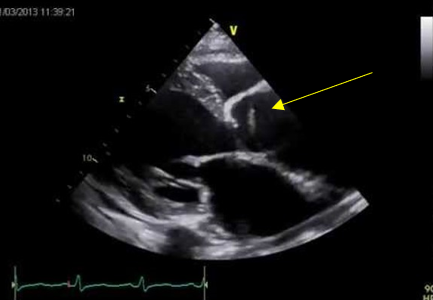(Image: Echocardiography of Ascending Aortic Dissection)
Echocardiography has been widely utilized to evaluate a variety of cardiac conditions including aortic dilatation / dissection, ventricular function, valvular heart disease, pericardial disease, cardiomyopathies, and more.
A comprehensive or focused cardiac ultrasound exam can be performed to augment the physical exam and other diagnostic testing to ensure accurate diagnosis and appropriate patient management.
Aortic dilatation or enlargement is the most common aortic abnormality. The normal adult aorta at the root level should not exceed approximately 3.7 cm. Causes of aortic dilatation are: atherosclerosis, hypertension, cystic medial necrosis, post- stenotic dilatation, collagen-vascular diseases, and inflammation.
AORTIC DISSECTION
Aortic dissection is a result of the intima of the vessel wall pulling away from the media or middle layer of the arterial wall. An intimal flap, or false channel is formed between the tear and the vessel. As a result, several complications can occur:
- The false lumen can expand and compress the true lumen which supplies the arterial branches arising from the aorta
- The intimal tear or flap can extend down the lumens of major arterial branches
- Thromboses can occur as a result of stasis of blood in the false lumen, and the vessel can rupture.
The Echocardiography Evaluation:
The echocardiography findings associated with aortic dissection typically reveal a thin, echogenic intimal flap with or without frank aneurysmal dilation. Typically, motion of the intimal flap is evident. (Kawamura, 71).
Doppler or color flow imaging may be helpful to differentiate the true lumen from the false lumen.
Depending on the type of dissection, the double lumen may extend into the abdominal aorta and involve the renal arteries and/or the iliac arteries. Dissection may also extend superiorly to the innominate, carotid, and/or subclavian vessels. It is important to demonstrate the entire extent of the dissection and any involvement of other vessels.
Transesophageal echocardiography has proven to be an excellent means of assessing the aorta for the detection of a dissection and is considered by some to be just as accurate, if not more than CAT scan and aortography.
In order to utilize ultrasound as an effective diagnostic tool, you must first learn how to perform and/or interpret echocardiography exams. Training begins with an understanding of the physics of ultrasound, cardiac anatomy, and how to perform the routine 2 dimensional views to evaluate chamber size and cardiac function. A comprehensive echocardiogram also includes performing quantitative measurements along with color, spectral Doppler, and Tissue Doppler techniques.
Ready to learn more and start incorporating echocardiography into your daily clinical practice? Come train with the best at our upcoming Introduction to Adult Echocardiography course December 4-8, 2023. This comprehensive course is taught by leading cardiac ultrasound experts and includes comprehensive lectures, interactive case presentations, and substantial hands-on skills training with the industry lowest 3:1 participant to instructor ratio for the most individualized attention.
So why wait? Call us or visit www.gcus.com to get yourself registered and start your path to becoming an echocardiography expert!



